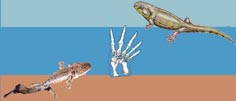Tim Kearsey's 2015 talk about Ballagan palaeosols to the Geological Society of America, Baltimore - abstract
The terrestrialization of vertebrates is one of the most important events in the evolution of life on Earth. New localities within the Lower Carboniferous (Tournaisian) Ballagan Formation in south-east Scotland are yielding tetrapod fossils that provide fresh insights into this pivotal period when tetrapods first became fully terrestrialized. A multi-proxy approach, combining palaeontology, micropalaeontology, sedimentology, palynology and geochemistry, is used to reconstruct early Carboniferous landscapes and ecosystem recovery following the End Devonian Mass Extinction.
Recently, new vertebrate fossils, including tetrapod remains, along with extensive plant, crustacean, ostracod and other invertebrate remains have been recovered from the Ballagan Formation. These discoveries reveal a rich variety of taxa, suggesting an explosive radiation of tetrapods and fishes following the End Devonian Mass Extinction.
The formation is characterized by alternating siltstones, sandstones, carbonates and evaporites on the 0.5 - 1 m scale. Sedimentary facies indicate frequent switching between alluvial-plain and coastal environments with many periods of pedogenesis and desiccation. Paleosol diversity suggests marshes coexisted with drier vertisols producing a varied set of micro-habitats.
Geochemical analyses of paleosols indicate a range in soil alkalinity and waterlogging which has controlled the type of paleosol that formed. Estimates of mean annual rainfall from paleosol compositions are in the range of 1000–1500mm per year. High mean annual rainfall and variable soil alkalinities alternate with the deep vertic* cracks and deposits of gypsum and anhydrite. Together these suggest a sharply contrasting seasonal climate with repeated cycles of wetting and drying. Spore and megaspore distribution demonstrates that reforestation in the earliest Carboniferous was not progressive but episodic in response to wetter climates.
Combining these data and proxies reveals the diverse niches that existed within increasingly complex ecosystems that developed across dynamic coastal environments and may have provided favourable conditions for more terrestrial tetrapod lifestyles.
* Vertic means any crack or structure which is formed by wetting and drying processes. So mudcracks caused by mud drying out in the sun are a type of vertic crack, but the term covers a wider range of features which form by the process of wetting and drying the soil. For more info, see Wikipedia articles Mudcrack and Vertisol

